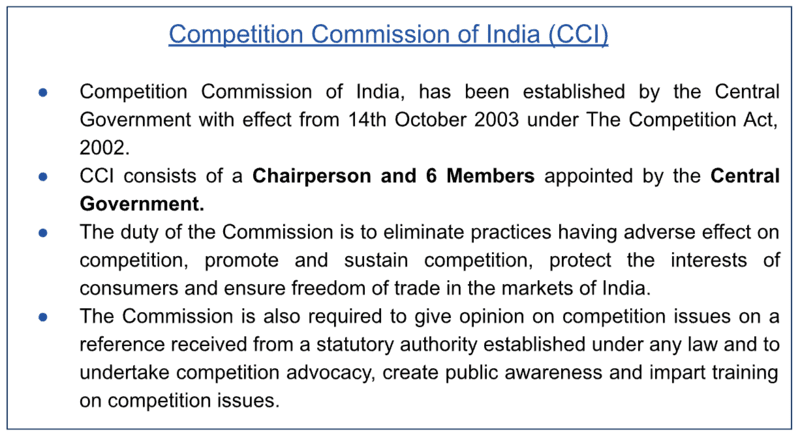GS Paper III
News Excerpt:
The Competition Commission of India (CCI) published draft regulations that would bring significant change its merger control regime.
- These regulations, along with the recent amendments to the Competition Act, 2002, seek to introduce some helpful changes that could impact deal-making in India.
About the New Merger Norms:
- The proposed regulations, titled the Competition Commission of India (Combinations) Regulations, 2023, lay out the specifics of the new framework for mergers and acquisitions introduced as part of the Competition (Amendment) Act, 2023, which was passed in April, 2023 to amend the Competition Act of 2002 to bring it up to speed with the digital markets.
- The draft CCI (Combinations) Regulations, 2023 elaborate on the following factors to consider when determining the value of deal criteria for "substantial business operations in India" - Different forms of notice to be filed with the CCI for a proposed combination, Procedure for filing notice and scrutiny of notice, Amount of fee and mode of payment and Procedure for modification to the proposed combination.
- These proposed regulations will repeal and replace the CCI (Procedure in regard to the transaction of business relating to combinations) Regulations, 2011, which currently governs the regulation of combinations in India. Key features of the Combinations Regulations, 2023 The Competition (Amendment) Act, 2023 introduced the concept of deal value threshold.
The Deal Value Threshold:
- One unhelpful introduction relates to introducing an additional notification threshold to stop “killer acquisitions” or deals that allow dominant firms to buy-out innovative firms to further their strength.
- Prior approval from the CCI will soon become mandatory for all transactions (involving targets with substantial business operations in India) valued at or above ₹2,000 crore.
- In defining “value of transaction”, the CCI appears to depart from its usual facilitative approach to instead anticipate and plug potential loopholes in the new threshold.
- For example, the draft regulations require transacting parties to aggregate the value of all the transactions, involving the same target, undertaken in the preceding two years, to determine the value of a transaction on a specific date.
- Parties must also look two years into the future and aggregate the value of all arrangements (for example, IPR licensing or supply agreements) connected or incidental to the transaction.
- This is likely to create more ambiguity than offer certainty. For example, in a two-year horizon, investors may invest funds through equity purchases multiple times in a start-up.
- While each investment may be unconnected with the earlier round, investors may need to notify their investments if they cross the ₹2,000 threshold in aggregate over two years and possibly even face CCI penalties for failure to notify earlier investments.
- Likewise, parties to an otherwise not notifiable transaction may be required to predict and assign a numerical value to all of their commercial arrangements with the target, whether or not they are connected to the deal, only because the arrangement takes place within 2 years of the deal. This could discourage transacting parties from exploring ways to collaborate beyond mere financial investment.
Advantages of the new merger norms:
- Due to the lack of an express mechanism in the Competition Act permitting on-market purchase of shares in listed companies, the CCI penalised companies for breaching the standstill requirement.
- The recent amendments and the proposed regulations address this legislative gap.
- Acquisition of listed shares, off an exchange, will no longer attract sanctions, if the acquirers notify the CCI within 30 days of completing the acquisition and do not “influence” the target during CCI’s review.
- Similarly, to make the merger control rules more business-friendly, the CCI has broadened the opportunities to offer “remedies” for addressing competition concerns in select transactions.
- The act offers only one formal opportunity for parties to propose remedies after the CCI expresses its preliminary opinion that the transaction may be anti-competitive.
- Historically, the CCI first makes a remedy proposal, followed by a counter-offer from the parties, which the CCI could either accept, reject or modify. This formalistic approach limited the parties’ ability to voluntarily make a first offer (although in practice, the CCI had begun to accept voluntary remedy proposals). The draft regulations seek to create more opportunities for parties to offer remedies.

